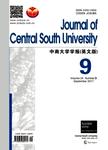Heat transfer and nanofluid flow over a porous plate with radiation and slip boundary conditions
辐射滑移边界条件下多孔板上的传热与纳米流体流动(英文)作者机构:Department of Mechanical EngineeringIsfahan University of TechnologyIsfahan 84156-83111Iran Department of Automotive and Marine Engineering TechnologyCollege of Technological StudiesThe Public Authority for Applied Education and TrainingKuwait Biomaterial Research GroupDepartment of Materials EngineeringIsfahan University of TechnologyIsfahan 84156-83111Iran Department of Mechanical EngineeringVali-e-Asr University of RafsanjanRafsanjanIran Division of Computational PhysicsInstitute for Computational ScienceTon Duc Thang UniversityHo Chi Minh CityVietnam Faculty of Electrical and Electronics EngineeringTon Duc Thang UniversityHo Chi Minh CityVietnam
出 版 物:《Journal of Central South University》 (中南大学学报(英文版))
年 卷 期:2019年第26卷第5期
页 面:1099-1115页
核心收录:
学科分类:080701[工学-工程热物理] 08[工学] 0807[工学-动力工程及工程热物理]
主 题:radiation slip condition porous surface heat generation/absorption viscous dissipation nanofluid
摘 要:Presence of different terms with various values can alter the thermal behavior of the nanofluids flow over porous *** aim of this research is to study the influence of nanoparticles volume fraction,nanoparticles type,suction or injection,the heat generation or absorption,the Eckert number,thermal and velocity slip parameters,and radiation on the velocity and temperature fields on the flow and heat transfer over a porous flat *** different types of nanoparticles including metal nanoparticles (Cu),metal oxide nanoparticles (Al2O3) and carbon-based nanomaterials (MWCNTs and SWCNTs) which were dispersed in the water (as based fluid) are *** governing equations are converted into the ordinary differential equations using similarity solution and solved numerically by the RKF45 *** results of the simulations showed a contradiction with the results of other researchers who expressed that using nanoparticles with higher thermal conductivity and volume fraction led to increasing heat transfer rate in nanofluids;this study proves that,in some cases,boosting the volume fraction of nanoparticles has a potential to decrease the heat transfer rate due to significant changes in values of some parameters including radiation,heat generation,and viscous dissipation.




